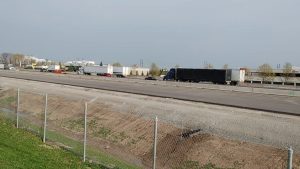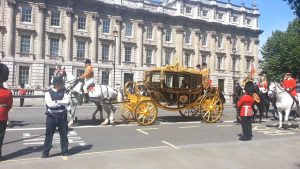 Dermot Jones, in uniform 1940s.
Dermot Jones, in uniform 1940s.Dermot Melbourne Herrington Jones was in his 30thyear when he jumped from the back of the Black Maria, his boots with those of his fellow officers clattering on the Kingston pavement as the police were dispatched to quell violence and disperse marchers supporting the labour unrest of 1938. It is intriguing to think that special constable Jones was the one who on May 23, pointed his Mark 7 at the crowd when Alexander Bustamante opened his jacket and pushed out his waistcoated chest and declared, Shoot me, but leave these defenceless, hungry people alone!” but it was not Dermot.
Dermot and Busta might even have been together at Up Park Camp, where Governor Richards had imprisoned the future National Hero in 1940, to keep him from arousing more labour discontent to gain an advantage while Hitler was giving England and Empire hell on the battlefields of Europe. But I doubt it because the stories I learned from gunner Jones were of being transported in trucks between the camp, Fort Rocky in Port Royal and Fort Clarence in the southern St Catherine seaside cliffs, to constantly watch the seas for the arrival of any German boats or submarines.
I’m not sure whether it was with the Jamaica Infantry Volunteers, Jamaica Reserve Regiment, the Jamaica Home Guard or the Jamaica Militia Artillery. He just called it the army but I’ve seen all those names refer to the forces that were securing Jamaica during World War II.
If he did have a commonality with Busta it was provoking the ire of those sent over from “the mother country” to be our leaders. One of Grandfather’s many army tales was of being on guard in the dark at a fort. He hears footsteps approach. He knows it is one of the English officers on the prowl: “Halt! Who goes there?!”
 A British accent replies. “Hands in the air and advance and be recognised!” barks gunner Jones with his Mark 7 at the ready and the white khaki clad figure approaches, face pale, hands in the air and, in grandfather’s view, ready to piss himself, but commending the gunner for his alertness. “‘Carry on Jones’, said the officer. But every time he approach after that he start to whistle and hit his trousers with his cane.” A small victory for the little man.
A British accent replies. “Hands in the air and advance and be recognised!” barks gunner Jones with his Mark 7 at the ready and the white khaki clad figure approaches, face pale, hands in the air and, in grandfather’s view, ready to piss himself, but commending the gunner for his alertness. “‘Carry on Jones’, said the officer. But every time he approach after that he start to whistle and hit his trousers with his cane.” A small victory for the little man.
Like Busta, reputed to be a good horseman to whom farmers sent their animals to be tamed, Grandfather had an early affair with horses. It started like this. Old Thomas Jones and his brother Jimmy, were posted to several police stations across the island, sometimes chasing thieves across rooftops, sometimes chasing skirts. About 1908, “The Old Man” arrived in St Ann and met Annie Henry, a young Indianish looking woman, whom he romanced before heading back to the estate at Picton, near Darliston, Westmoreland, in the far west of the island.
So on October 28th of that year, in the same parish that Marcus Garvey was born some years before and Bob Marley would be some years later, there arrived little Dermot. Somehow, he ended up at Picton with The Old Man, who used Dermot as his little slave, because while the “lawful” children with Miss Viv were off to school, Dermot would be helping The Old Man around the farm, drying coffee, pimiento or some other grain on the concrete barbecue behind the house, rounding up and slaughtering animals and smoking the meat in the outside kitchen and taming horses.
It was the horses that Dermot loved and he became a skilled jockey – the main reason he missed school. At 14, he was a short and tough little boy who The Old Man took to the various tracks around the island to race his horses. The one Dermot loved best being on a south coast beach in St Elizabeth.
“When I jump off in front there is no way they can catch me because I have the horse kicking sand in their eyes,” he would brag as an older man, me absorbing the stories.
At some time in the 1930s the Jones children began migrating from Picton. The boys and girls first settled in Kingston. They lived in what were then the residential areas of the city, many of which are now regarded as ghetto: Admiral Pen, Jones Pen, Allman Town, Rollington Pen, with the squat, muscular Dermot and Ken acting as bodyguards against any who would dare offend their pretty light brown skinned sisters.
Soon the girls and younger brother John John would be off to the USA and later we would receive movie star-like pictures of them in red and blue edged air mail envelopes as they stood in magical scenes outside tall buildings we only saw in magazines and films. Ken with his better schooling ended up a supervisor at Soap and Edible Products (Seprod) in Kingston before going to America after early retirement.
And Dermot pressed on in Kingston, meeting a woman who gave him Clarry, a son who was his spitting image, except that he did not have his father’s pretty hair which never needed combing “just some grease or water and brush it back”. Clarry went off to England in the 50s and became a clippie on the bus and his mother would show up from time to time in straw hats during the 60s saying she was back from Freeport, Bahamas. Rumour had it she was in Bellevue.
Dermot flitted around Kingston, hopping on and off tram cars like all the saga boys of the day and worked out at a gym while learning the craft of boxing in a career that did not last long – although from his accounts there was nobody in his lightweight class who could beat him. I think it was a butt to the face from a competitor that made Dermot opt out of the ring.
It must have been about then that he met Hilda Scarlett from Logwood, whose father was also a roving lover boy, because he had children along the north coast from Portland to Hanover, where she was born in 1907. When they met she already had two boys, one of them my Daddy, who would wonder whether he would ever get “muscles and veins in his arms” like his stepfather.
Thus began the taming of a male shrew because as I have told you before, Dermot cleaned up his swaggering act and was in the police reserve, perhaps following in The Old Man’s footsteps, and later in the militia after meeting Hilda.
Army life ended with an honourable discharge because of some raging fever that took a hold of D as Hilda had dubbed him. (He seldom called her Hilda, but Miss Jones, contracted to Mi Jones, which I suspect was the name she used when they met while she worked as an assistant in a dental office. In those days birth certificates did not have the father’s name if a child was born out of wedlock and Hilda Eulalee was the “female child of Annie Jones, of Santoy, Logwood Dist”.)
I doubt the fever was malaria from the mosquito infested forts, as it never haunted him in life after I met him in the mid ’50s when I joined the family, but D was sure it was related to his being born in October, “a rainy month” which condemned him to a life plagued with colds.
D ventured into business. After the war, the colonial government offered to those who had served in the military some lands in the hills on the north east side of Kingston. Hilda took one look at the bush and rocks and told D to take cash instead. (The lands became the luxury residential area of Beverley Hills.) He invested the cash in a furniture store in Blount Street, west Kingston, somewhere in the area of the Kingston Public Hospital. Mi Jones gave up her job to become a housewife like her friend Kitten, the wife of a rising police officer who would become head of the force.
The furniture shop foundered and closed. Mi Jones never returned to work and D, who she had brought to church via her sabbath keeping faith, became a contractor and painter. His business card: For a good and competent painter, see Bro D.M. Jones. Tel: His core team members were Steby (Stephenson, who lived “awn de west”) and Willie (Mr Williams who lived in a neat little concrete bungalow in McGregor Gully, east Kingston).
We were regaled with endless stories about Steby, Willie and the boys on the painting job at places like Light and Power, which was being built or refurbished at Foreshore Road, which I believe is now Marcus Garvey Drive, and violent confrontations on the Sandy Gully construction project.
It was mainly from politics that the drama on the sites unfolded because no public jobs were had without the involvement of party bosses. And astute Grandfather was a card carrying member of the Jamaica Labour Party (JLP) and the People’s National Party (PNP), attending their branch (JLP) and group (PNP) meetings in our community of Vineyard Town. It was how you got a piece of the painting action on the National Arena in 1966, or to supervise a few chains of the rowdy broom and machete crew of Christmas road workers.
Since by the time I hit the fifth grade at primary school I was a more fluent reader and legible writer than Grandfather ever was, I got exposed to business early, drafting his dictated estimates for material and labour to be presented for private jobs, a task that was previously the domain of Mi Jones, my Grandmamaa. If I could read and write better than him, he declared he couldn’t be beaten with “ciphering” and he spit out the sum of the estimate in pounds, shillings and pence in no time flat.
Most of his crew were old soldiers I believe because, he and Willie, an older man than Grandfather, used to attend Jamaica Legion ex-soldiers’ meetings together on Sundays at Curphey Place, Up Park Camp.
He never took his customers or his trade for granted. When water-based distemper paints were introduced, they dried leaving a powdery surface that easily dusted or washed off. He decided to boil glue and add it to the paint, a method which apparently worked. He took his idea to Caribbean Spray and Paint with a bit of wood covered in his distemper glue mix, rubbed it to show clean fingers and they told him they’d get back to him. They never did but water paints did lose their dusty characteristic.
When he joined the army he said, the recruits were told they were there “for rations and discipline”. In later life the discipline must have been in the way he saved with the burial societies on Wildman Street in the city and at church, with the government savings bond programme, hoping desperately that his number would be called one Saturday night for a 10,000 pounds prize, and buying shares in the Matalon’s ICD Group of Companies and Kingston Industrial Works. Once a year they sent him a few shillings (later dollars) and an annual report or certificates for split shares and an annual report. I wonder what happened to his shares?
When Grandfather’s sight left him in the 1990s while I lived in the Eastern Caribbean, and Grandmamaa’s memory began to fade, he was admitted to a Jamaican Legion home in the cool central Jamaica town of Mandeville. It was here that, unknown to me, Grandfather died. Later when I got the news that he had already been buried in an unmarked grave in Kingston’s May Pen Cemetery, a little bit of me died.
I doubt any of his then surviving siblings or his nieces or nephews of either his father’s or mother’s side had got the news, scattered as they had been for years in North America and England. I, his grandson, did not. The good thing though, is that in Jamaica’s Heroes’ Month, more than a dozen years later he is remembered not just as the “good and competent painter” or the old soldier, who it is said never dies anyway, but as one of the unsung heroes who tried to build the dreams of the Bustas and the Garveys.
Do you have a story of an unsung hero you’d like to share. Please submit it to [email protected]


About Mark Lee
Mark Lee has been a long-time journalist writing, editing and producing in print, radio television and new media.










